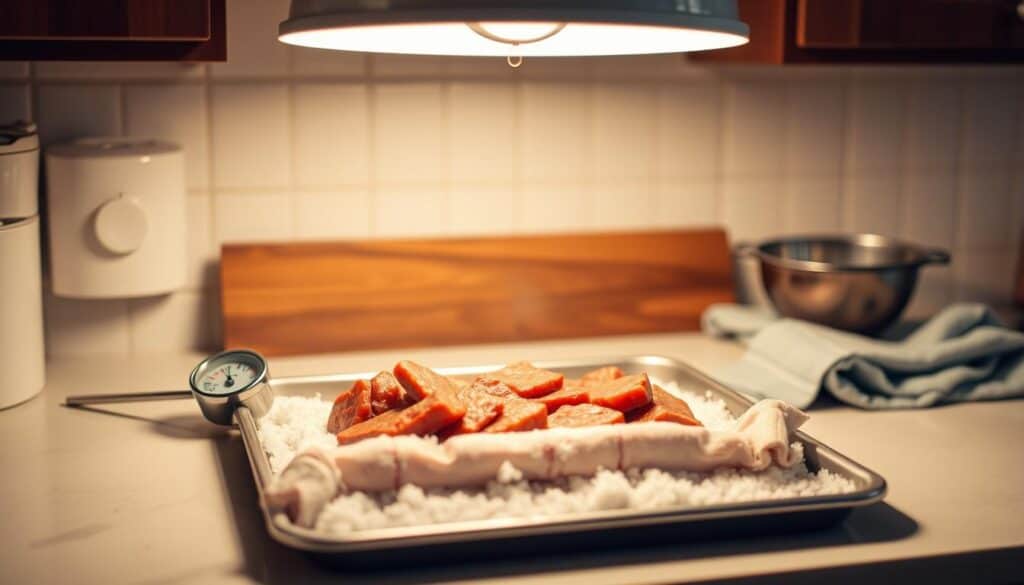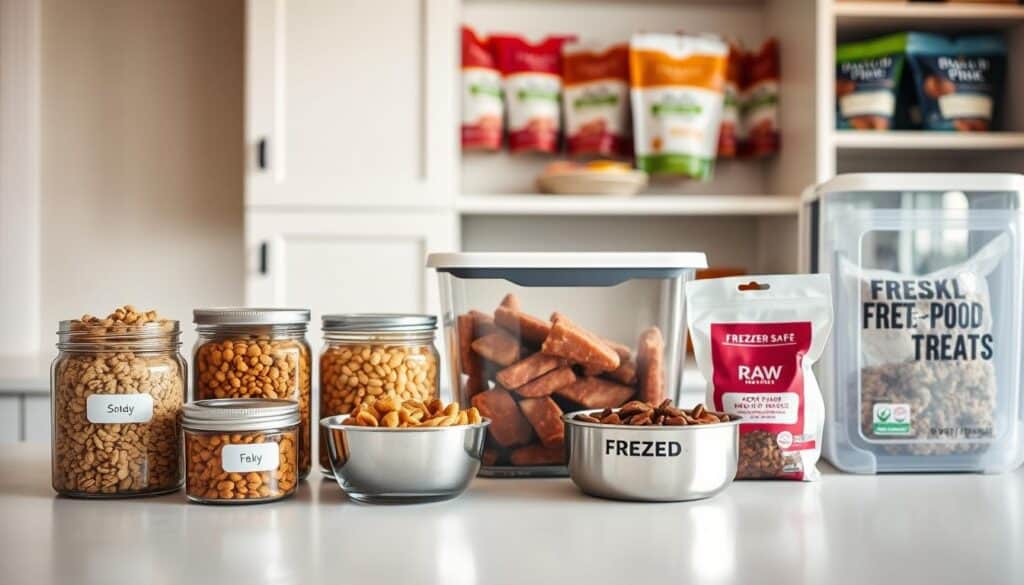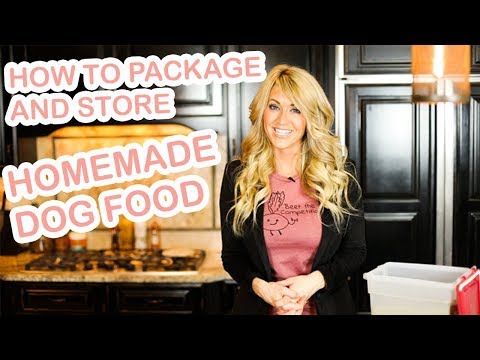As a responsible pet parent, ensuring your dog gets the best nutrition is a top priority. Fresh pet food is an excellent choice, but sometimes you might find yourself with more than you can use before it spoils. This is where freezing comes into play—a practical solution to preserve your dog’s meals without compromising on quality.
In this guide, we’ll walk you through everything you need to know about freezing fresh pet food. From preparation tips to safe storage practices, we’ve got you covered. Our advice is based on Freshpet’s guidelines and expert recommendations to ensure your pet’s food remains nutritious and flavorful.
Freezing is a great way to manage excess portions, especially if you’ve bought a bulk bag of food. However, it’s important to do it correctly to maintain the food’s integrity. We’ll discuss the best methods to freeze, thaw, and store your dog’s meals safely. Whether you’re looking to save time or reduce waste, this guide will provide you with actionable tips to make the most of your pet food.
So, let’s dive in and explore how you can preserve your dog’s food effectively. By the end of this article, you’ll be confident in your ability to handle and store your pet’s meals like a pro!
Key Takeaways
- Freezing is a viable option for preserving fresh pet food.
- Proper preparation and storage are crucial for maintaining food quality.
- Follow safe thawing practices to ensure your dog’s meals remain nutritious.
- Portion control can help in managing the amount of food you freeze.
- Always prioritize your pet’s safety and the food’s nutritional value.
Understanding Fresh Pet Dog Food and Its Benefits
Fresh pet dog food has become a popular choice for many pet owners due to its natural ingredients and health benefits. Unlike processed foods, fresh pet food is made with real meat, fruits, and vegetables, offering a more holistic approach to your dog’s nutrition.
What Makes Fresh Pet Food Unique?
Fresh pet food stands out for its use of high-quality, natural ingredients. It avoids artificial preservatives and fillers, making it a healthier option for your dog. The recipes are carefully crafted to ensure a balanced mix of nutrients, vitamins, and minerals essential for your dog’s well-being.
Nutritional Value and Optimal Ingredients
The key to fresh pet food’s effectiveness lies in its nutrient-dense ingredients. Real meat provides essential proteins, while fruits and vegetables add fiber, vitamins, and minerals. This balanced formulation supports digestion and overall health. Additionally, the gentle preparation methods used preserve the food’s nutritional integrity, ensuring your dog gets the most out of each meal.
| Ingredient Type | Benefits |
|---|---|
| Real Meat | High-quality protein source for muscle health |
| Fruits and Vegetables | Rich in vitamins, minerals, and antioxidants |
| Whole Grains | Provide sustained energy and fiber |
Fresh pet food is not just a meal; it’s a commitment to your dog’s health. With its focus on natural ingredients and balanced nutrition, it’s a choice that aligns with the desire for a home-style, wholesome diet for your pet.
When to Consider Freezing Pet Food
Knowing when to freeze your pet’s leftovers can make a big difference in maintaining their meal quality. Whether it’s uneaten portions or bulk purchases, freezing is a practical solution that preserves nutrition and freshness.
Reasons to Freeze Leftovers
Freezing is especially useful when your pet doesn’t finish their meal. It helps reduce waste and keeps the food fresh for later. Additionally, if you buy in bulk, freezing allows you to store portions without compromising quality.
| Situation | Why Freeze | Benefit |
|---|---|---|
| Uneaten Meals | Prevents spoilage and waste | Keeps food fresh for future meals |
| Bulk Purchases | Manages larger quantities | Ensures convenient meal portions |
| Exposure Time | Freeze before spoilage | Maintains nutritional value |
According to Freshpet’s guidelines, leftovers should be refrigerated promptly and can be frozen to extend shelf life. Freezing not only preserves the meal but also retains its nutritional benefits. While Freshpet recommends serving food fresh, freezing is a viable option when done correctly, ensuring your pet’s meals remain nutritious and flavorful over time.
Proper Preparation Before Freezing Fresh Dog Food
Preparing your dog’s meals for freezing requires careful attention to detail to ensure quality and safety. This step is crucial for maintaining the nutritional value and flavor of the food. By following a structured approach, you can ensure your pet enjoys healthy, delicious meals even after freezing.
Portioning and Packaging Techniques
Portioning your dog’s food accurately is essential. Use a kitchen scale or measuring cups to divide the food into servings that match your pet’s meal requirements. For example, if your dog eats a cup of food per meal, portion it accordingly to avoid waste and ensure consistency.
When packaging, consider using plastic bags, aluminum foil, or plastic wrap. These materials help create an airtight seal, which is vital for preventing freezer burn. Remove as much air as possible from storage bags before sealing to maintain freshness. Label each portion with the date to keep track of how long it’s been stored.
Ensuring Airtight Storage
Airtight storage is key to preserving the quality of your dog’s food. Use high-quality plastic bags or containers designed for freezing. If using foil or plastic wrap, ensure the food is tightly covered to prevent air exposure. Proper packaging not only reduces freezer burn but also helps retain the food’s natural flavors and textures.
By following these simple steps, you can keep your dog’s meals fresh and nutritious for a longer period. Remember, proper preparation is the first step toward successful freezing and serving healthy meals to your pet.
can you freeze fresh pet dog food
Freshpet is designed for refrigeration, but freezing is a safe option under the right conditions. This method is especially helpful for pet parents who buy in bulk, ensuring meals remain nutritious and flavorful.
When freezing, use proper storage bags to prevent freezer burn and maintain freshness. Freshpet recommends freezing for up to 3 months. While the texture might change upon thawing, the nutritional content stays stable when stored correctly. Always follow guidelines for storage duration in both the fridge and freezer.
How to Safely Freeze Fresh Pet Dog Food
Freezing fresh pet dog food can be a convenient way to maintain its quality and extend its shelf life. However, it requires careful preparation to ensure your dog’s meals remain nutritious and safe to eat. Below is a step-by-step guide to help you freeze your pet’s food effectively.
Step-by-Step Freezing Instructions
Start by pre-cooling the food in the refrigerator before freezing. This step helps prevent the growth of harmful bacteria. Once cooled, portion the food into manageable sizes based on your dog’s meal requirements. Use a kitchen scale or measuring cups for accuracy.
Transfer the portions into airtight containers or high-quality freezer bags. Remove as much air as possible from the bags before sealing to prevent freezer burn. Label each container or bag with the date and contents for easy tracking.
Best Containers and Packaging Options
Choose containers that are specifically designed for freezing, as they provide better protection against moisture and air. If using plastic bags, ensure they are freezer-safe and tightly sealed. Proper packaging is crucial to maintain the food’s quality and prevent contamination.
Freezing at 0°F (-18°C) or below is ideal for preserving the food’s nutritional integrity. Frozen meals can typically be stored for up to three months without significant loss of quality. When you’re ready to serve, simply thaw the desired portion in the refrigerator overnight.
By following these steps, you can safely freeze your dog’s meals and ensure they remain fresh and nutritious for a longer period. Proper freezing techniques not only save time but also help maintain the food’s texture and flavor, giving your pet the best possible dining experience.
Thawing and Reheating Frozen Dog Food
Thawing and reheating frozen dog food requires attention to detail to ensure safety and quality. Proper methods help prevent bacterial growth and maintain nutritional value.
Refrigerator Thawing Best Practices
Refrigerator thawing is the safest method for defrosting pet food. It prevents bacterial growth and keeps the food fresh. Freshpet recommends thawing in the refrigerator for about 24 hours. This slow process ensures even thawing without compromising the food’s texture or nutrients.
Microwave Guidelines for Even Heating
For quicker reheating, a microwave can be used gently. It’s important to stir or flip the food for even heating. Measure the correct amount before reheating to avoid excess. Overheating can destroy nutrients and create hot spots, so keep the time short and check the temperature.
| Method | Time | Benefits |
|---|---|---|
| Refrigerator | 24 hours | Prevents bacteria, maintains quality |
| Microwave | 30-60 seconds | Quick, even heating with stirring |

Following these steps ensures your pet’s meals remain nutritious and tasty. Always prioritize safe handling to preserve the food’s quality and your pet’s health.
Storage Duration and Quality Considerations
When it comes to freezing fresh pet dog food, understanding how long it can be stored while maintaining its quality is essential. According to Freshpet’s guidelines, frozen pet food should ideally be used within 3 months to ensure optimal taste and nutritional value.
Avoiding Freezer Burn
Freezer burn is a common issue that can affect the texture and flavor of your pet’s meals. It occurs when food is exposed to air in the freezer, causing dehydration and the formation of ice crystals. To prevent freezer burn, always store food in airtight containers or freezer-safe bags, ensuring as much air is removed as possible before sealing.
Maintaining Texture and Nutritional Value
Proper storage is key to preserving both the texture and nutrients of your pet’s food. Use high-quality freezer bags or containers designed for long-term storage. Label each portion with the date to keep track of how long it’s been frozen. While some texture changes may occur after thawing, the nutritional integrity remains intact when stored correctly.
After thawing, you might notice slight changes in appearance, but these do not affect the safety or nutritional value of the food. Proper storage methods, such as using airtight containers, will help maintain quality over time and ensure the best result for your pet’s meals.
DIY Storage Methods Using Everyday Kitchen Supplies
Storing fresh pet food doesn’t always require specialized containers. Everyday kitchen items can be just as effective for keeping your dog’s meals fresh and nutritious. Let’s explore some practical DIY storage solutions using items you likely have on hand.
Plastic Bags, Aluminum Foil, and Plastic Wrap
One of the simplest storage options is using gallon-sized plastic bags. These bags are ideal for portioning your dog’s food, and when sealed properly, they provide a good barrier against air and moisture. To ensure optimal freshness, press out as much air as possible before sealing. This method is both cost-effective and easy to implement.
Another option is aluminum foil. Wrap the food tightly in a layer of foil to prevent exposure to air. While this method doesn’t offer the same level of protection as a plastic bag, it’s a viable alternative when other supplies are unavailable. For added protection, consider placing the foil-wrapped food inside a plastic bag.
Plastic wrap can also be used to cover containers or create a makeshift bag. Stretch the wrap tightly over the container or around the food, ensuring no air can reach it. This method is less durable than foil but can work in a pinch.
| Method | Pros | Cons |
|---|---|---|
| Plastic Bags | Cost-effective, easy to use, good barrier against air | May not be as durable for long-term storage |
| Aluminum Foil | Readily available, easy to wrap | Less protection against moisture |
| Plastic Wrap | Convenient for small portions | Less durable, may not seal as tightly |
These DIY methods are not only budget-friendly but also help extend the life of your pet’s food while preserving its nutritional value. Many pet owners have successfully used these techniques to keep their dog’s meals fresh and ready for serving.
Maintaining Nutritional Integrity After Freezing
Proper freezing and thawing techniques play a crucial role in preserving the essential vitamins and minerals in your pet’s food. When done correctly, these processes help maintain the food’s nutritional balance, ensuring your pet continues to receive the necessary nutrients for healthy growth and development.
Preserving Vitamins and Minerals
Freezing is a reliable method for retaining the nutritional value of your pet’s meals. According to Freshpet’s guidelines, when food is frozen at 0°F (-18°C) or below, the formation of ice crystals helps preserve vitamins and minerals. This process minimizes the breakdown of water-soluble vitamins like vitamin C and B vitamins, which are essential for your pet’s immune system and energy levels.
Proper storage is key to maintaining the balance of nutrients. Using airtight containers or freezer-safe bags ensures that the food is protected from air and moisture, which can cause nutrient degradation. By labeling each portion with the date, you can keep track of how long it’s been stored, ensuring you serve meals within the recommended three-month window for optimal quality.
When thawing, it’s important to handle the food carefully to minimize nutrient loss. Refrigerator thawing is the safest method, as it allows for a slow, even thawing process without exposing the food to harmful bacteria. This method helps retain the food’s texture and prevents the loss of water-soluble vitamins, ensuring your pet’s meals remain nutritionally balanced.
A controlled kitchen environment also plays a role in preserving food quality. By storing frozen meals in a dedicated freezer at a consistent temperature, you prevent fluctuations that could affect nutrient integrity. This attention to detail ensures that your pet’s food remains nutritious and flavorful, supporting their overall health and growth.
By following these guidelines, you can maintain the nutritional integrity of your pet’s food, providing them with the essential nutrients they need for a healthy, active life. Proper freezing and thawing techniques not only preserve the food’s quality but also give you peace of mind, knowing your pet is receiving the best possible nutrition.
Additional Tips and Tricks for Handling Fresh Pet Food
Managing your pet’s meals effectively involves more than just storage—it’s about creating a routine that supports their health and your convenience. Here are some expert tips to help you handle fresh pet food like a pro.
Managing Portion Sizes and Meal Timing
Portion control is crucial for maintaining your pet’s health. Measure accurately to avoid overfeeding, especially for smaller breeds. For larger dogs, divide their meals into 2-3 portions to prevent gobbling and aid digestion.
Timing is everything. Feed your pet during their most active hours to boost digestion. Morning and early evening meals are ideal. For busy schedules, prepare meals in advance but thaw only what’s needed to prevent waste.
Monitor ambient temperature in your kitchen to prevent spoilage. Store food in a cool, dry place before refrigerating or freezing. Label and date all portions to ensure you use the oldest ones first, minimizing waste.
For efficiency, use freezer-safe bags and press out air before sealing. This prevents freezer burn and keeps food fresh. Consistency is key, so stick to a feeding schedule to maintain your pet’s digestive health.
By following these tips, you can ensure your pet enjoys nutritious, flavorful meals while reducing waste and saving time. Happy feeding!
Safety Precautions When Serving Frozen Dog Food
Serving frozen dog food requires careful handling to ensure your furry friend stays healthy. Proper thawing and serving techniques are crucial to prevent foodborne illnesses and maintain the food’s quality.
Preventing Bacterial Growth and Foodborne Illnesses
When thawing frozen dog food, always use the refrigerator method. This prevents bacterial growth and keeps the food safe. Never leave thawed food at room temperature for more than two hours, as bacteria can multiply rapidly.
- Thaw food in the refrigerator overnight for even thawing.
- Keep thawed portions in airtight containers to prevent contamination.
- Avoid cross-contamination by using separate utensils for thawed and frozen food.
According to Freshpet’s guidelines, proper handling is key to maintaining safety. Always follow the recommended storage times and ensure your freezer is at 0°F (-18°C) to preserve the food’s integrity.
By following these safety tips, you can ensure your dog enjoys nutritious, safe meals. Always prioritize proper food handling to protect your pet’s health and well-being.
Comparing Freezing Versus Refrigeration for Pet Food Storage
When deciding how to store your pet’s meals, understanding the differences between freezing and refrigeration is key. Both methods have unique benefits and drawbacks that affect shelf life, nutrient retention, and convenience.
Refrigeration is ideal for short-term storage, keeping food fresh for about 3-5 days. It maintains the food’s texture and flavor without freezing. However, it requires more attention to prevent spoilage and bacterial growth. On the other hand, freezing extends shelf life up to 3 months, preserving nutrients and preventing bacterial growth, but it may slightly alter texture upon thawing.
Temperature control differs significantly between the two methods. Refrigerators typically maintain a temperature of about 39°F (4°C), while freezers operate at 0°F (-18°C) or below. These temperature differences impact how food quality and safety are maintained over time.
In terms of convenience, refrigeration is better for immediate use, allowing quick access without thawing. Freezing is more convenient for long-term storage, enabling portion control and reducing waste. However, freezing requires proper packaging to prevent freezer burn and maintain quality.
For pet parents, the choice depends on usage scenarios. If meals are consumed within a few days, refrigeration is practical. For longer periods or bulk purchases, freezing is the better option. Both methods, when done correctly, support your pet’s health by preserving nutrients and preventing bacterial growth.
| Storage Method | Shelf Life | Temperature | Pros | Cons |
|---|---|---|---|---|
| Refrigeration | 3-5 days | 39°F (4°C) | Maintains texture, fresh flavor | Shorter shelf life, risk of spoilage |
| Freezing | Up to 3 months | 0°F (-18°C) | Preserves nutrients, prevents bacteria | Texture changes, requires thawing |

Conclusion
In conclusion, freezing fresh pet dog food is a safe and convenient option for maintaining its quality and extending shelf life. By following proper preparation, storage, and thawing techniques, you can ensure your pet enjoys nutritious meals for up to three months. Proper packaging in airtight containers or freezer-safe bags is essential to prevent freezer burn and maintain flavor. When thawing, using the refrigerator method helps preserve nutrients and prevents bacterial growth.
Key tips include portioning meals accurately, labeling with dates, and using DIY storage methods like plastic bags or aluminum foil. Always prioritize your pet’s health by adhering to safety precautions and timely consumption. With the right approach, freezing offers a practical solution for pet parents seeking to provide high-quality, wholesome meals without compromise.




